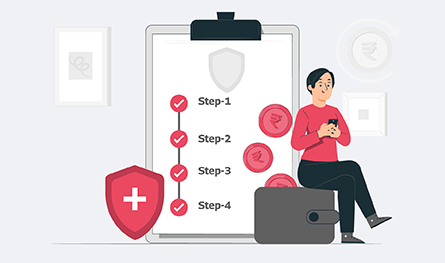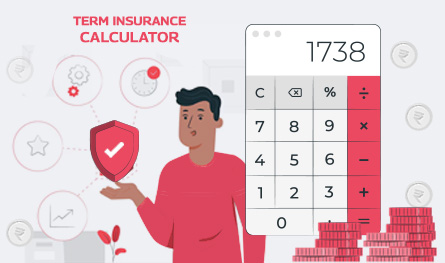Related Articles
 Jan 08, 2025
Jan 08, 2025
Is Varicose Vein surgery covered under the health insurance policy in India
 Health Insurance
Health Insurance

A health insurance reimbursement claim is made when the insured visits a non-network hospital for treatment. Most health insurance policies offer a wide network of hospitals where the insured can avail of a cashless claim. However, knowing the process of raising a reimbursement claim is important for every policyholder. Let's take a look at the step-by-step process to fill out the reimbursement form to raise a health insurance claim.

The best part about getting health insurance for you and your loved ones is that you never have to worry about bearing the financial burden of healthcare costs in case of emergencies. And to make the process even more smooth for you is the exclusive advantage of cashless hospitalization provided by most insurers. This facility can be availed at any of the network hospitals near you, which is provided by your insurance company.
However, it cannot be ignored that medical emergencies can come in uncalled for anytime, anywhere. What if you don’t have access to one of your insurer’s network hospitals at that time? Treatment cannot wait and so you’d need to avail whatever best you have at your disposal at the time. Your insurance company would, however, reimburse the costs borne by you at a non-network hospital up to the limit covered by your insurance plan.
For this, your insurer would ask you to simply fill out a health insurance reimbursement form, a simple document with all the details of your treatment and the costs borne therewith. Read on to know more about this form and how exactly to fill it out in case you ever have to.
As stated above, your insurance company may require you to fill out a reimbursement form in case you did not avail of cashless hospitalization at one of the network hospitals of the insurer. This form is generally handed over to the patient after they have been discharged from the hospital. The patient must submit this claim reimbursement form, along with the other relevant documents, to their insurance company within 15 days of being recharged, after which the company may not entertain your reimbursement claim request.
Here’s how you can complete your claim reimbursement form easily and without making any mistakes:
You would need to submit the relevant details such as the policy number, your name and contact details.
This would include filling out the insurance company’s name under which the patient is covered, the policy number of that health insurance plan, and the total sum insured under that plan. Besides, you may also need to furnish details about prior hospitalization history, if any, and any prior record of insurance coverage for the hospitalization.
You would need to fill out the name of the insured, their relationship with the primary insured person under the policy, their contact details, and their occupation.
You’d be required to collect all original reports for the treatment from the hospital, right from the date of admission until the date of filing the claim. You’d also need all original receipts of hospital bills for all tests conducted as well as pharmacy bills. In case you have any receipts of lump sum cash benefit received from the insurer, attach those as well along with the other documents.
The claim amount would need to be computed based on the pre-hospitalization costs incurred, the expenses borne during the hospitalization of the insured patient, the post-hospitalization costs incurred for the patient, as well as any other costs involving use of ambulance or any health check-ups performed (if applicable).
The insurer would require you to provide your bank name and branch, bank account number, IFSC code, PAN details, and Cheque/DD details.
Make sure to look through the entire form again once you have completed filling it. At the end, the insured would need to provide their signature and mention the date of filing the claim. Also ensure that Part-B of the form (as described in the above section) has been duly filled in by the hospital.

Paybima Team
Paybima is an Indian insurance aggregator on a mission to make insurance simple for people. Paybima is the Digital arm of the already established and trusted Mahindra Insurance Brokers Ltd., a reputed name in the insurance broking industry with 17 years of experience. Paybima promises you the easy-to-access online platform to buy insurance policies, and also extend their unrelented assistance with all your policy related queries and services.

If you think of life insurance, chances are you are picturing something people buy in their 30s or 40s. But what if you are 65 or older and just getting started? The good news is that you are never too late. Whether you are thinking of easing the financial burden on your family, covering final expenses, or simply leaving behind a legacy, there are life insurance options tailored just for you.
This article will be a guide to life insurance for senior citizens above 65 years, explaining why it is important, the type of insurance options, and how to get the right policy for you.


Have you ever caught yourself lost in illusions about your daughter's future events, such as her university convocation and first day at work? Her university convocation. When she embarks upon her initial job after graduation will be the day.


Let’s be honest – life insurance planning isn’t exactly someone’s weekend hobby. It is the financial equivalent of flossing: we understand its importance, but we tend to put it off. But somewhere between balancing work and life, you might realise you need to have a solid plan in place – just in case.


We all know that health insurance policies offer a long list of inclusions. However, exclusions are also a crucial aspect of every policy. Overlooking policy documents can surprise you with hidden clauses that you didn't even know existed. To avoid such unpleasant situations and unexpected expenses during medical emergencies, it is crucial to uncover hidden clauses your health insurance policy may contain. When you buy health insurance online, make sure to know all about the policy before signing the document.
From least known exclusions to waiting periods and conditions in the fine print, hidden clauses can affect your overall experience. To help you out, here are the top hidden clauses of a health insurance policy that you should know.

.png)
Lymphocytes, a kind of white blood cells, are an extraordinary army of defenders functioning in the bustling world of our immune system for our body’s immune defence. Let’s know about these mighty warriors who are continually waging war against invading pathogens, viruses, and microbes in detail.
